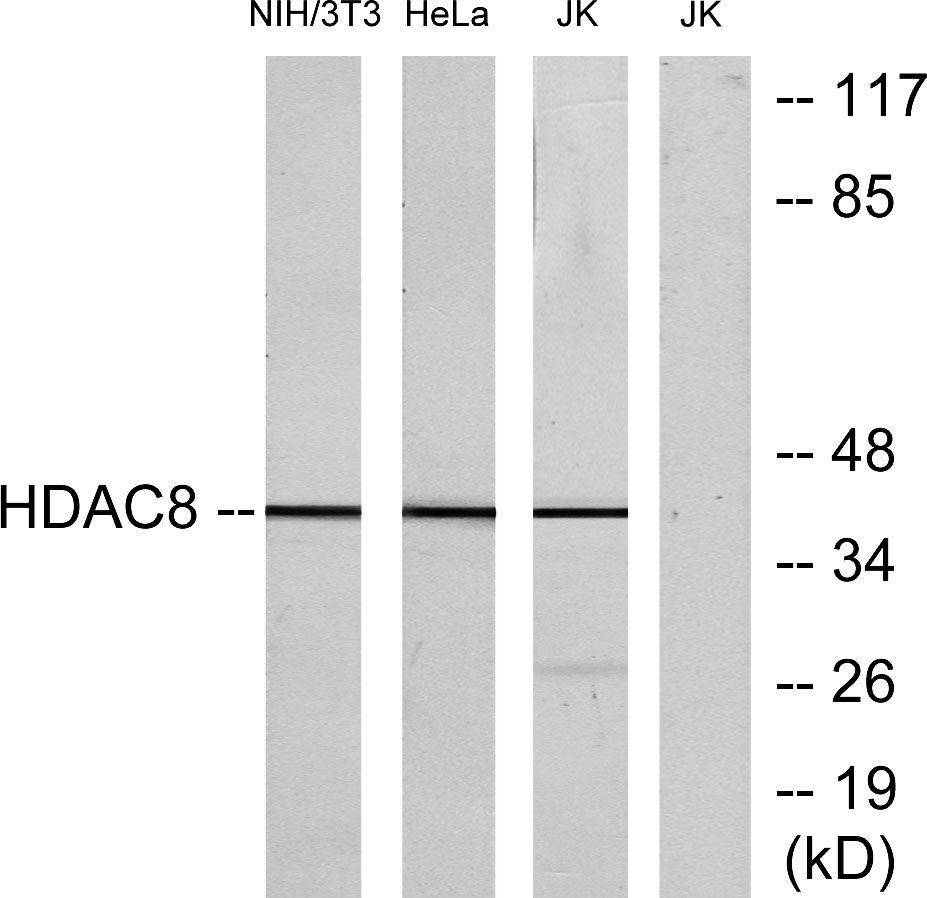HDAC8 Polyclonal Antibody
- Catalog No.:YT2120
- Applications:WB;IHC;IF;ELISA
- Reactivity:Human;Mouse;Rat;Monkey
- Target:
- HDAC8
- Fields:
- >>Neutrophil extracellular trap formation;>>Alcoholism;>>Viral carcinogenesis
- Gene Name:
- HDAC8
- Protein Name:
- Histone deacetylase 8
- Human Gene Id:
- 55869
- Human Swiss Prot No:
- Q9BY41
- Mouse Gene Id:
- 70315
- Mouse Swiss Prot No:
- Q8VH37
- Rat Gene Id:
- 1.00912e+008
- Rat Swiss Prot No:
- B1WC68
- Immunogen:
- The antiserum was produced against synthesized peptide derived from human HDAC8. AA range:5-54
- Specificity:
- HDAC8 Polyclonal Antibody detects endogenous levels of HDAC8 protein.
- Formulation:
- Liquid in PBS containing 50% glycerol, 0.5% BSA and 0.02% sodium azide.
- Source:
- Polyclonal, Rabbit,IgG
- Dilution:
- WB 1:500 - 1:2000. IHC 1:100 - 1:300. ELISA: 1:20000.. IF 1:50-200
- Purification:
- The antibody was affinity-purified from rabbit antiserum by affinity-chromatography using epitope-specific immunogen.
- Concentration:
- 1 mg/ml
- Storage Stability:
- -15°C to -25°C/1 year(Do not lower than -25°C)
- Other Name:
- HDAC8;HDACL1;CDA07;Histone deacetylase 8;HD8
- Observed Band(KD):
- 42kD
- Background:
- Histones play a critical role in transcriptional regulation, cell cycle progression, and developmental events. Histone acetylation/deacetylation alters chromosome structure and affects transcription factor access to DNA. The protein encoded by this gene belongs to class I of the histone deacetylase family. It catalyzes the deacetylation of lysine residues in the histone N-terminal tails and represses transcription in large multiprotein complexes with transcriptional co-repressors. Multiple transcript variants encoding different isoforms have been found for this gene. [provided by RefSeq, Oct 2009],
- Function:
- catalytic activity:Hydrolysis of an N(6)-acetyl-lysine residue of a histone to yield a deacetylated histone.,caution:The sequence shown here is derived from an Ensembl automatic analysis pipeline and should be considered as preliminary data.,function:Responsible for the deacetylation of lysine residues on the N-terminal part of the core histones (H2A, H2B, H3 and H4). Histone deacetylation gives a tag for epigenetic repression and plays an important role in transcriptional regulation, cell cycle progression and developmental events. Histone deacetylases act via the formation of large multiprotein complexes.,miscellaneous:Its activity is inhibited by trichostatin A (TSA) and butyrate, two well known histone deacetylase inhibitors.,similarity:Belongs to the histone deacetylase family. Type 1 subfamily.,subcellular location:Excluded from the nucleoli.,subunit:Interacts with PEPB2-MYH11, a f
- Subcellular Location:
- Nucleus . Chromosome . Cytoplasm . Excluded from the nucleoli (PubMed:10748112). Found in the cytoplasm of cells showing smooth muscle differentiation (PubMed:15772115, PubMed:16538051). .
- Expression:
- Weakly expressed in most tissues. Expressed at higher level in heart, brain, kidney and pancreas and also in liver, lung, placenta, prostate and kidney.
- June 19-2018
- WESTERN IMMUNOBLOTTING PROTOCOL
- June 19-2018
- IMMUNOHISTOCHEMISTRY-PARAFFIN PROTOCOL
- June 19-2018
- IMMUNOFLUORESCENCE PROTOCOL
- September 08-2020
- FLOW-CYTOMEYRT-PROTOCOL
- May 20-2022
- Cell-Based ELISA│解您多样本WB检测之困扰
- July 13-2018
- CELL-BASED-ELISA-PROTOCOL-FOR-ACETYL-PROTEIN
- July 13-2018
- CELL-BASED-ELISA-PROTOCOL-FOR-PHOSPHO-PROTEIN
- July 13-2018
- Antibody-FAQs
- Products Images

- Western Blot analysis of various cells using HDAC8 Polyclonal Antibody diluted at 1:1000
.jpg)
- Western Blot analysis of 293-UV cells using HDAC8 Polyclonal Antibody diluted at 1:1000

- Immunohistochemistry analysis of paraffin-embedded human lung carcinoma tissue, using HDAC8 Antibody. The picture on the right is blocked with the synthesized peptide.

- Western blot analysis of lysates from NIH/3T3, HeLa, and Jurkat cells, , using HDAC8 Antibody. The lane on the right is blocked with the synthesized peptide.



